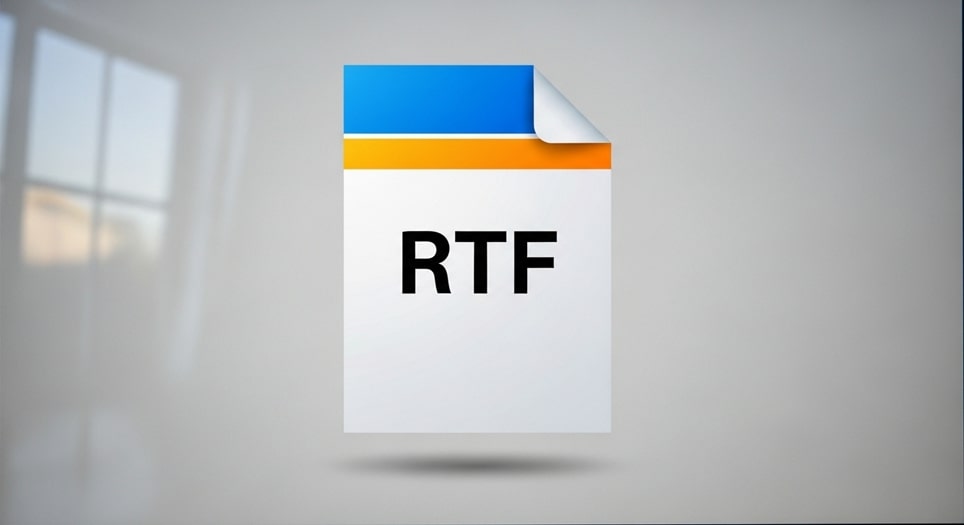
What Is an RTF File and How Do I Open One?
Rich Text Format (RTF) files represent one of the most enduring and versatile document formats in the digital world, serving as a universal bridge between different word processing applications and operating systems. Developed by Microsoft Corporation from 1987 until 2008, RTF is a proprietary document file format with published specifications designed for cross-platform document interchange. Unlike simple text files that contain only plain characters, RTF files preserve essential formatting elements such as fonts, colors, styles, and basic layout structures while maintaining compatibility across diverse software platforms. This unique positioning makes RTF files particularly valuable in professional environments where document sharing between different systems and applications is commonplace.
The fundamental appeal of RTF lies in its ability to strike a balance between functionality and compatibility that many other formats struggle to achieve. While modern formats like DOCX offer more advanced features, they often face compatibility issues when shared between different software versions or platforms. RTF files, by contrast, can be opened and edited by virtually any word processing application, from Microsoft Word and Google Docs to simpler text editors like WordPad and TextEdit. This universal compatibility stems from RTF’s open specification and its use of readable formatting codes that can be interpreted by various applications, making it an ideal choice for documents that need to be accessible across different computing environments.
In today’s digital landscape, RTF files continue to play a crucial role despite the proliferation of newer document formats. They are frequently used in legal documents, academic papers, email templates, and corporate communications where consistent formatting and universal accessibility are paramount. Many content management systems, email clients, and document processing workflows rely on RTF as an intermediate format because of its reliability and predictable behavior across different platforms. Understanding how to work with RTF files effectively can enhance your document management capabilities and ensure seamless communication in professional and personal contexts where file format compatibility is essential.
Understanding the RTF File Format Structure and Capabilities
The Rich Text Format operates on a sophisticated yet accessible structure that combines human-readable control words with document content, creating files that can be interpreted by both specialized applications and simple text editors. RTF was unique in its simple formatting control which allowed non-RTF aware programs like Microsoft Notepad to open and provide readable files. This architecture uses bracketed control sequences and plain text content, enabling the format to encode formatting information without requiring proprietary decoding algorithms. The format supports essential formatting features including font specifications, paragraph alignments, character styling, basic tables, and embedded images, providing comprehensive document creation capabilities while maintaining cross-platform compatibility.
RTF’s formatting capabilities encompass a wide range of text styling options that meet most standard document requirements without overwhelming complexity. The format supports multiple font families, sizes, and colors, along with standard text attributes like bold, italic, and underline formatting. Paragraph-level formatting includes alignment options, indentation controls, line spacing adjustments, and bullet point or numbered list creation. These features enable users to create professionally formatted documents that maintain their appearance across different applications and platforms, making RTF suitable for business correspondence, reports, and other formal documents where consistent presentation is important.
One of RTF’s most significant advantages lies in its handling of special characters and international text support, though with some limitations compared to modern Unicode-based formats. To be standard-compliant RTF, non-ASCII characters must be escaped, which can make files larger when dealing with international content. The format includes mechanisms for embedding images and objects, though these capabilities are more limited than those found in contemporary formats like DOCX or HTML. Despite these constraints, RTF’s robust support for essential formatting features and its predictable behavior across different systems make it an excellent choice for documents that prioritize reliability and accessibility over advanced multimedia capabilities.
RTF files distinguish themselves from other formats through their unique approach to balancing functionality with compatibility. Unlike binary formats that require specific decoders, RTF’s text-based structure allows for partial readability even when viewed in applications that don’t fully support the format. This characteristic proves invaluable in troubleshooting scenarios or when working with legacy systems that may not support newer document formats. The format’s stability and maturity also contribute to its continued relevance in professional environments where document integrity and long-term accessibility are critical considerations.
Step-by-Step Guide to Opening RTF Files
Opening RTF files successfully requires understanding the various methods available and choosing the approach that best suits your specific needs and available software. Most modern computer systems include built-in applications capable of handling RTF files, making the process straightforward for users across different platforms. The key to successfully opening RTF files lies in identifying the appropriate application for your intended use, whether you need simple viewing capabilities, basic editing functions, or full-featured document processing. Understanding your options ensures that you can access RTF content quickly and efficiently while maintaining the document’s formatting integrity.
- Double-Click Method for Default Application OpeningThe most straightforward approach to opening RTF files involves using your operating system’s default file association settings by simply double-clicking the file icon. You are likely to already have an app installed that can open the RTF file – like Microsoft Word or WordPad on a Windows PC or Apple Pages or Apple TextEdit on a Mac. This method leverages your system’s file association database, which determines which application launches when you interact with specific file types. The default association is typically established during software installation or can be configured through your operating system’s settings panel.Windows users will commonly find that RTF files open in either Microsoft Word (if installed) or WordPad, which comes pre-installed with Windows operating systems. WordPad provides excellent RTF support with full formatting preservation and basic editing capabilities, making it suitable for most RTF file interactions. Mac users typically see RTF files open in TextEdit or Pages, depending on their system configuration and installed applications. Both applications provide comprehensive RTF support with varying levels of editing sophistication.If the double-click method doesn’t produce the desired result or opens the file in an application you prefer not to use, you can modify your system’s default file associations. This process varies by operating system but generally involves right-clicking the RTF file, selecting “Open with” or similar option, choosing your preferred application, and setting it as the default for RTF files. This one-time configuration ensures future RTF files automatically open in your preferred application.
- Using the Right-Click Context Menu for Application SelectionThe right-click context menu provides immediate access to multiple application options for opening RTF files without changing your default file associations. This method is particularly useful when you want to open an RTF file in a different application than your system default, such as using a simple text editor instead of a full word processor for quick viewing. Right-clicking on the RTF file reveals an “Open with” submenu that displays all applications registered to handle RTF files on your system.From the context menu, you can select specific applications based on your immediate needs. For example, you might choose Microsoft Word for full-featured editing, Notepad for code-level viewing of RTF markup, or a web browser for a different perspective on the content. This flexibility allows you to match the application to your specific task without permanently altering your system’s file associations. The context menu typically shows recently used applications at the top of the list, followed by recommended applications and a “Choose another app” option for accessing additional possibilities.Some operating systems also provide preview options directly from the right-click menu, allowing you to examine RTF content without fully launching an application. This preview functionality can be particularly helpful when you need to quickly verify file contents or when working with multiple RTF files and need to identify specific documents efficiently. The context menu approach offers maximum flexibility while preserving your preferred default settings for routine file operations.
- Opening RTF Files Through Application File MenusMany users prefer opening RTF files through their preferred application’s File menu, particularly when working within an established workflow or when the desired application is already running. This method provides precise control over which application handles the RTF file and often offers additional options during the opening process. Most word processors, text editors, and document viewers include RTF in their supported file type lists, making this approach widely applicable across different software environments.To use this method, launch your preferred application first, then navigate to File > Open or use the keyboard shortcut (typically Ctrl+O on Windows or Cmd+O on Mac). Browse to the location of your RTF file using the file dialog box, select the file, and click Open. Some applications may display additional options during this process, such as encoding settings or import preferences that can affect how the RTF content is interpreted and displayed.This approach is particularly valuable when working with applications that offer specialized RTF handling features or when you need to open multiple RTF files simultaneously. Professional word processors often provide enhanced RTF import options that can optimize formatting preservation or offer conversion settings for specific workflows. Using the File menu method also ensures that any application-specific RTF handling preferences or customizations are properly applied during the opening process.
- Drag-and-Drop Operation for Quick File AccessThe drag-and-drop method offers an intuitive and efficient way to open RTF files, particularly when working with file explorers and application windows simultaneously. This approach involves selecting the RTF file in your file manager and dragging it directly onto an appropriate application window or icon. Most modern applications that support RTF files will accept drag-and-drop operations, making this method both convenient and widely compatible across different software environments.To use drag-and-drop effectively, ensure that your target application is visible on screen, either as an open window or as an icon in your taskbar or dock. Select the RTF file in your file explorer, hold down the mouse button, and drag the file over the application. Most applications will provide visual feedback, such as highlighting or cursor changes, to indicate that they can accept the file. Release the mouse button when positioned over the target application to initiate the opening process.This method is especially useful when working with multiple files or when switching between different applications for various RTF documents. Drag-and-drop operations often bypass some of the file association logic, allowing you to open RTF files in applications that might not be configured as default handlers for the format. Some applications also support dropping multiple RTF files simultaneously, enabling batch opening operations that can significantly streamline document processing workflows.
Compatible Applications and Software Options
The versatility of RTF files is reflected in the extensive range of applications that can open, edit, and create these documents across different operating systems and software categories. Understanding your options enables you to choose the most appropriate tool for your specific needs, whether you require basic viewing capabilities, comprehensive editing features, or specialized document processing functions. The compatibility spectrum ranges from simple text editors that provide basic RTF support to sophisticated word processors that offer full-featured RTF handling with advanced formatting preservation and editing capabilities.
Microsoft Office applications, particularly Microsoft Word, provide the most comprehensive RTF support due to Microsoft’s role in developing and maintaining the format specification. Word offers complete RTF compatibility with full formatting preservation, advanced editing capabilities, and seamless conversion options to other document formats. Other Microsoft Office applications like Outlook use RTF extensively for email composition and storage, making the format integral to many business communication workflows. Office 365 and Microsoft 365 subscriptions ensure access to the latest RTF handling improvements and compatibility updates.
Cross-platform alternatives include Google Workspace applications, which provide excellent RTF support through web-based interfaces accessible from any device with internet connectivity. Google Docs can open, edit, and export RTF files while maintaining formatting integrity and enabling collaborative editing features. Web-based document viewers like Google Docs provide reliable support for RTF files, allowing for collaborative editing. This cloud-based approach is particularly valuable for teams working across different operating systems or for users who need consistent RTF access regardless of their physical location or device limitations.
Apple’s productivity suite offers robust RTF support through Pages, TextEdit, and other macOS applications. Pages provides professional-grade RTF handling with excellent formatting preservation and export capabilities, while TextEdit offers lightweight RTF support suitable for basic editing and viewing tasks. These applications integrate seamlessly with macOS workflows and provide native RTF support that maintains the format’s cross-platform compatibility advantages. iOS versions of these applications extend RTF accessibility to mobile devices, enabling document access and editing on smartphones and tablets.
RTF vs Other Document Formats: A Comprehensive Comparison
Understanding how RTF compares to other document formats helps users make informed decisions about when to use RTF files and when alternative formats might be more appropriate. The document format landscape includes various options, each with specific strengths, limitations, and optimal use cases. RTF occupies a unique position in this ecosystem, offering a balance of functionality and compatibility that makes it valuable in specific scenarios while acknowledging that other formats may be better suited for certain applications or requirements.
Comparing with DOC format, RTF has less formatting capability than DOC, supporting formats like italics, font sizes, types, and boldface, while being unable to store large amounts of data like DOC. The DOCX format represents Microsoft’s modern approach to document storage, utilizing XML-based structures that enable advanced features like complex layouts, embedded multimedia, advanced graphics, and sophisticated formatting options. However, this increased capability comes at the cost of compatibility, as DOCX files require compatible software for proper rendering and editing. RTF’s simpler structure trades some advanced features for broader compatibility and more predictable behavior across different applications and systems.
Plain text (TXT) files represent the opposite end of the spectrum from RTF, offering maximum compatibility and minimal file sizes but without any formatting capabilities. RTFs are a level up from TXT files and are more like regular word processing documents with a ‘.rtf’ file extension. While TXT files can be opened by virtually any application and are ideal for code, configuration files, and simple notes, they cannot preserve formatting, fonts, or document structure. RTF bridges this gap by providing essential formatting capabilities while maintaining broader compatibility than more complex formats like DOCX or PDF.
| Format | Compatibility | File Size | Formatting Support |
|---|---|---|---|
| RTF | Excellent across platforms | Moderate, larger than TXT | Basic to intermediate formatting |
| DOCX | Good with compatible software | Efficient compression | Advanced formatting and features |
| TXT | Universal compatibility | Minimal file size | No formatting support |
| Excellent for viewing | Variable, often compressed | Preserves exact layout |
PDF files excel in preserving exact document layout and appearance across different systems, making them ideal for final documents, forms, and publications where visual consistency is critical. However, PDF editing requires specialized software and can be more complex than RTF editing. RTF files offer easier editing capabilities and better integration with word processing workflows, while PDF files provide superior layout preservation and are better suited for documents that need to maintain precise formatting regardless of the viewing application or system.
Creating and Editing RTF Files
Creating RTF files involves using word processing applications that support RTF export or working directly with applications that use RTF as a native format. The creation process typically begins with composing your document in any capable word processor, applying desired formatting, and then saving or exporting the file in RTF format. Most modern word processors include RTF in their “Save As” or export options, making the creation process straightforward and accessible. The key to successful RTF creation lies in understanding the format’s capabilities and limitations to ensure that your document’s formatting translates effectively into the RTF structure.
Microsoft Word provides one of the most comprehensive RTF creation experiences, offering full access to RTF’s formatting capabilities while providing clear feedback about which features will be preserved in the final file. To save a document as RTF in Word, one simply creates or opens a document and then saves it as a .rtf file by clicking “File” > “Save As” and selecting “Rich Text Format”. During the save process, Word automatically converts advanced formatting that isn’t supported by RTF into compatible alternatives, ensuring that the resulting file maintains maximum compatibility while preserving as much formatting as possible.
Editing RTF files requires understanding both the capabilities and limitations of the format to avoid introducing incompatible elements or losing formatting during the editing process. Most RTF-compatible applications provide seamless editing experiences that preserve the format’s structure and formatting codes. When editing RTF files, focus on using formatting features that are well-supported by the format, such as basic font styling, paragraph formatting, and simple tables. Avoid complex layouts, advanced graphics, or proprietary formatting features that may not translate well to RTF or may be lost when the file is opened in different applications.
Best practices for RTF editing include regularly saving your work, testing the file in multiple applications to ensure compatibility, and maintaining awareness of the target audience’s likely software environment. If your RTF file will be shared with users who have limited software options, focus on basic formatting that will display consistently across different applications. For more sophisticated formatting needs, consider whether RTF is the appropriate format or if alternatives like DOCX or PDF might better serve your requirements while still meeting your compatibility needs.
Troubleshooting Common RTF File Issues
RTF files, despite their robust design and broad compatibility, can occasionally present challenges that require systematic troubleshooting approaches. Understanding common issues and their solutions enables users to quickly resolve problems and maintain productive workflows when working with RTF documents. The most frequent issues include formatting inconsistencies between applications, file corruption, encoding problems, and compatibility conflicts with specific software versions. Developing effective troubleshooting skills ensures that RTF-related problems don’t significantly impact your document processing activities.
Formatting inconsistencies represent one of the most common challenges when working with RTF files across different applications. These issues typically manifest as fonts changing unexpectedly, paragraph spacing appearing different than intended, or bullet points and numbering displaying incorrectly. Such problems often arise from differences in how various applications interpret RTF formatting codes or from missing fonts on the target system. To address formatting inconsistencies, try opening the file in different applications to identify whether the issue is application-specific or inherent to the file. Consider using more commonly available fonts and simpler formatting structures to improve cross-platform consistency.
File corruption issues can occur due to incomplete downloads, storage media problems, or software errors during file creation or editing. Corrupted RTF files may display garbled text, refuse to open, or cause application crashes. When encountering suspected corruption, first attempt to open the file in multiple applications, as some programs may be more resilient to minor corruption than others. If the file remains problematic, check for backup copies or earlier versions that might be undamaged. Some specialized file recovery tools can repair damaged RTF files, though success rates vary depending on the extent and nature of the corruption.
- Character Encoding Problems: These issues often appear as strange symbols or question marks replacing normal text, particularly with international characters. Try opening the file in different applications with various encoding settings, or use a text editor to examine the raw RTF codes for encoding declarations.
- Application Crashes or Freezing: When RTF files cause software instability, the issue may be related to memory constraints or incompatible formatting codes. Try opening the file on a different computer or in a different application to isolate the problem source.
- Large File Size Issues: RTF files with embedded images or extensive formatting may become extremely large. Use file compression tools or save the document in a more efficient format if file size becomes problematic for sharing or storage.
- Font Substitution Problems: Missing fonts on the target system can dramatically alter document appearance. Stick to common system fonts or embed font information when possible to minimize substitution issues across different systems.
- Table and Layout Corruption: Complex tables or layouts may not transfer correctly between applications. Simplify table structures and avoid advanced layout features that may not be consistently supported across RTF implementations.
- Print Formatting Discrepancies: RTF documents may print differently than they appear on screen due to printer driver differences or margin interpretation variations. Test print formatting on target systems when precise layout is critical.
- Version Compatibility Conflicts: Older RTF versions may not support newer formatting features, causing compatibility issues. Save files in earlier RTF versions when compatibility with legacy systems is required.
Prevention strategies can significantly reduce the likelihood of encountering RTF-related problems. Regularly save your work in multiple formats to create fallback options, test RTF files in various applications before final distribution, and maintain awareness of your target audience’s likely software environment when creating RTF documents. Keep applications updated to benefit from improved RTF handling and bug fixes. When sharing RTF files, consider providing brief instructions about recommended applications or settings that optimize display and editing capabilities.
Advanced RTF Tips and Best Practices
Maximizing the effectiveness of RTF files requires understanding advanced techniques and best practices that optimize compatibility, performance, and user experience across different applications and platforms. These sophisticated approaches go beyond basic file creation and editing to encompass strategic decisions about formatting, sharing, and long-term document management. Professional users who regularly work with RTF files can benefit significantly from implementing systematic approaches that ensure consistent results and minimize potential complications in collaborative or cross-platform environments.
Template creation and standardization represent powerful strategies for maintaining consistency across multiple RTF documents while streamlining the creation process for routine document types. Developing standardized RTF templates with approved fonts, formatting styles, and layout structures ensures that all documents maintain professional appearance and consistent behavior across different applications. These templates can include predefined paragraph styles, standard headers and footers, and approved color schemes that work well within RTF’s capabilities while providing sufficient visual appeal for professional communications.
Version control strategies become particularly important when working with RTF files in collaborative environments where multiple users may edit documents using different applications. Establishing clear naming conventions, maintaining change logs, and using file comparison tools help track modifications and prevent conflicts when merging edits from different sources. Consider implementing checkout systems or collaborative platforms that can handle RTF files effectively while maintaining format integrity throughout the revision process.
Optimization techniques for RTF files focus on balancing functionality with file size and performance considerations. Remove unnecessary formatting codes, optimize embedded images for appropriate resolution and compression, and eliminate redundant styling that can bloat file sizes without providing meaningful benefits. Regular cleanup of RTF files, particularly those that have undergone extensive editing, can improve loading times and reduce potential compatibility issues. Understanding which formatting features provide the best return on investment helps create more efficient and reliable RTF documents.
Converting RTF Files to Other Formats
Converting RTF files to other document formats enables users to leverage the strengths of different file types while maintaining document content and formatting integrity. The conversion process involves understanding the capabilities and limitations of target formats to make appropriate adjustments during the transformation. Whether converting to PDF for final distribution, DOCX for advanced editing, or HTML for web publishing, each conversion scenario requires specific considerations to achieve optimal results while preserving essential document elements.
PDF conversion from RTF files provides excellent results for documents intended for final distribution, archival, or situations where layout preservation is critical. Adobe Acrobat can convert RTF files to PDF format, retaining the original formatting of the RTF file during the conversion process. Most word processors with RTF support also include PDF export capabilities that maintain formatting while creating universally accessible documents. The conversion process typically preserves fonts, layouts, and basic formatting while creating files that display consistently across different systems and applications.
DOCX conversion opens up access to Microsoft Word’s advanced features while maintaining compatibility with the broader Microsoft Office ecosystem. This conversion is particularly valuable when RTF’s formatting limitations become constraints for document requirements. The process typically preserves all RTF formatting while enabling access to features like advanced tables, sophisticated graphics handling, and enhanced collaboration tools. However, converting to DOCX may reduce compatibility with non-Microsoft applications, requiring careful consideration of your document’s intended audience and distribution requirements.
HTML conversion transforms RTF documents into web-compatible formats suitable for online publishing, email templates, or integration with web-based content management systems. This conversion process requires understanding how RTF formatting translates to HTML and CSS structures, as some formatting elements may require manual adjustment for optimal web display. The resulting HTML files offer excellent cross-platform compatibility and can be further customized using web development techniques, making this conversion valuable for digital publishing workflows.
The Future of RTF in Modern Document Management
The Rich Text Format continues to maintain relevance in modern document ecosystems despite the proliferation of newer, more feature-rich formats. Its enduring value lies in providing a stable, reliable foundation for document interchange in environments where compatibility and predictability are more important than cutting-edge features. As businesses and organizations grapple with increasingly complex software environments and diverse user bases, RTF’s universal compatibility becomes even more valuable for ensuring that critical documents remain accessible regardless of specific software availability or version compatibility issues.
Contemporary applications for RTF files have evolved to leverage the format’s strengths while working within its limitations. Legal document systems, government communications, academic publishing workflows, and corporate documentation processes continue to rely on RTF for its stability and broad acceptance. The format’s role in email systems, content management platforms, and automated document generation systems demonstrates its continued utility in professional environments where reliability and consistency are paramount concerns.
Looking forward, RTF’s role is likely to remain stable as a reliable intermediary format for document interchange, though its importance may shift as cloud-based collaboration tools and web-based document editors continue to evolve. The format’s simplicity and maturity make it an excellent choice for archival purposes and long-term document preservation, where the ability to access content decades in the future becomes a critical consideration. Understanding RTF’s capabilities and optimal use cases ensures that users can continue leveraging this stable, reliable format effectively within modern document management strategies.
The key to successful RTF utilization in contemporary environments lies in understanding when the format’s strengths align with specific requirements and when alternative formats might provide better solutions. By maintaining proficiency with RTF files while staying aware of evolving document format landscapes, users can make informed decisions that optimize their document workflows while ensuring long-term accessibility and compatibility. This balanced approach enables effective participation in diverse document ecosystems while maintaining the flexibility to adapt to changing technological requirements and collaboration patterns.










